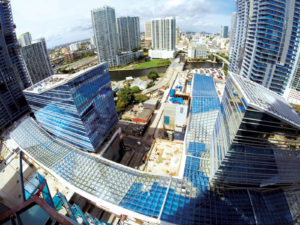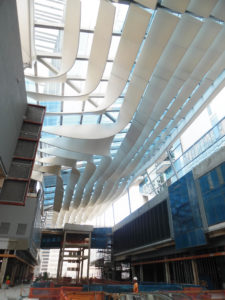
The Brickell City Centre, a new $1.05 billion, 5.4-million-square-foot, mixed-use development in downtown Miami, Fla., has it all. There are luxury residences, a hotel, office space and a five-story pedestrian mall with shops, restaurants and cafés.
Connecting this vast space into one architectural statement is a 100,000-square-foot canopy called the Climate Ribbon™. Made of faceted steel and glass, the T-shaped covering undulates between the complex’s buildings. Its fluid ceiling features sinuous blades of steel tubing covered with architectural fabric membranes. To resist weather, the membranes are made from type 10839 PTFE glass. It’s extremely tough, but also stiff and barely extendable
to fit properly on the blades.
Much more than merely a design element, the Climate Ribbon provides a microclimate within the pedestrian mall to protect shoppers against the Miami sun and provide natural, cooling air circulation, using passive energy design strategies.
 Designed by architect Hugh Dutton, of Hugh Dutton Associés, Paris, France, what appears to have been achieved with playful ease is actually the result of highly complex membrane detailing and extremely precise fabrication and assembly.
Designed by architect Hugh Dutton, of Hugh Dutton Associés, Paris, France, what appears to have been achieved with playful ease is actually the result of highly complex membrane detailing and extremely precise fabrication and assembly.
The steel and glass structure consists of triangular panels joined in such a way as to create the undulating up-and-down effect. While the area fills with natural light, the blades are specifically angled to prevent direct sunlight, shading the facades of shops and terraces directly. They are also positioned to create air circulation by harnessing the summer trade winds coming off Biscayne Bay and pulling gentle breezes through the public spaces for natural cooling.
 TEXTILES.ORG
TEXTILES.ORG


